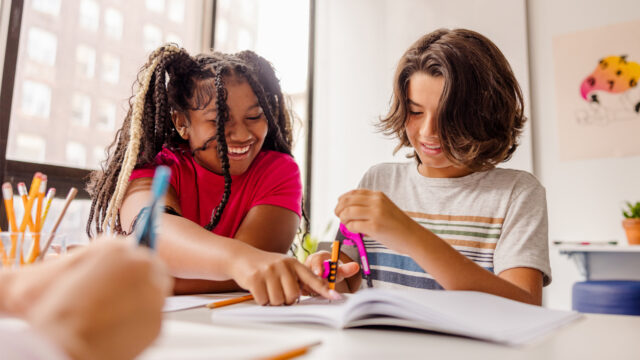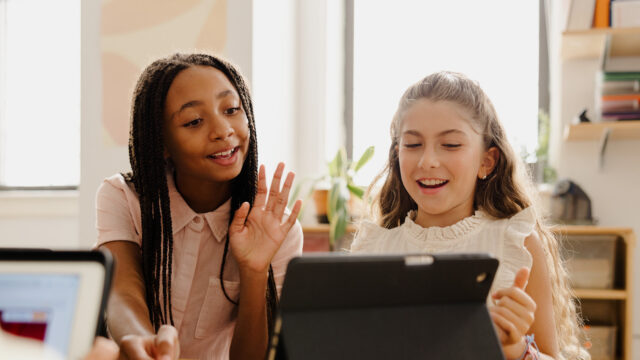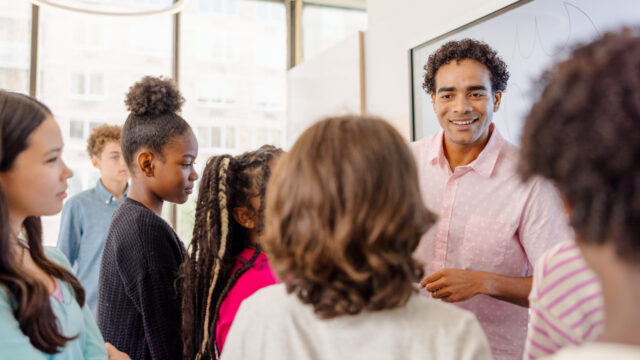
The brain has a big job to do in the classroom. Taking in information, learning, remembering—the brain is working hard to grow each day. Brains are intricately connected to learning through biological and chemical processes. What if we, as teachers, could plan activities tailored to how the brain already functions?
Well, good news: it’s not only possible, but you’re probably already using brain-based learning strategies in your classroom! Let’s explore a few examples and see how they’re linked to brain functions so that you can maximize the benefits for your students.
Brain-based learning activities to motivate your students
1. Splash of color
The human brain loves the aesthetic experiences found in artworks like paintings and sculptures. In one 2019 study, researchers Stefano Mastandrea, Sabrina Fagioli, and Valeria Biasi explain how when our brains process aesthetically pleasing artwork, it activates “reward-related brain areas,” which in turn increases “the individual predisposition to cognitive activities such as learning.”
In other words, we not only like to look at art, but it helps us learn, too. It can help build new synaptic connections and prune inefficient, older ones. “There are several regions in the brain . . . that work to help you determine what is salient,“ write Susan Magsamen and Ivy Ross in Your Brain on Art: How the Arts Transform Us. “Arts and aesthetic experiences emerge as major conduits for greater saliency,” they explain. “So, arts and aesthetics can quite literally rewire your brain.”
When planning your lessons, seek out activities that connect artworks to learning goals. In an ELA class, this might be writing an essay that describes and analyzes a sculpture. In a social studies class, students can study details like the clothing, architecture, or objects included in a painting. Even just incorporating some color into a lesson can reap benefits. In one 2022 study, Ukrainian researchers suggest that students remember information better when it is color coded.
2. Move for attention
Studies seem to show that students will invariably struggle if they are tasked with paying continuous attention for long stretches of time. “The truth,” explains Laura Erlauer in The Brain-Compatible Classroom, “is that their minds were probably wandering at least every 20 minutes.” That number—around 20 minutes—is roughly the maximum attention span that most of us reach as adults.
In 2020, authors Eric Jensen and Liesl McConchie published their third edition of Brain-Based Learning and describe a few ways of aligning your teaching to your students’ (and your!) natural attention spans. One strategy is to incorporate physical activity, with overwhelming evidence of its benefits on attention. “The benefits of physical activity on student attention are both immediate and prolonged,” they explain. It can be used in short bursts to help students focus on a task immediately afterwards, yet “it is the sustained habit of physical activity that shows the most impressive impact.”
3. Relax with music
Current research, like this 2020 study from Giovanni Sala and Fernand Gobet, indicates that the human brain does not typically transfer music training to learning in other subject areas. However, “the human brain is built for sound,” writes musician James DiDomenico, who lists ways that teachers can leverage the neurological and cognitive benefits of music to students. Having words sung instead of spoken can increase phonemic awareness and be “linked to instruction on prosody, intonation, and phrasing.” Musicologist Patricia Shehan Campbell explains as well how music can help with regulating emotions in the classroom. Upbeat music can help with “enlivening children who appear lethargic,” while relaxing music “can create calm to help them wind down.”
Special education expert Lucille Foran writes that especially for children with learning disabilities, “listening to music appears to help students access parts of their brains that function poorly or not at all.” She points out music’s apparent connection to memory and cites the benefits specifically to learners who have experienced trauma. This is in line with evidence that music benefits learning across other special populations, too, such as students learning a second language or students with autism.
4. Let content settle
The brain is not a computer that you can simply reprogram to learn something new. It is instead a complicated organ that learns in smaller pieces that require time to be integrated into a larger body of understanding. “The evidence is strong that interval learning is superior to ‘massed’ learning,” writes Eric Jensen in Teaching with the Brain in Mind. “After a learning session, do what you can to give students a way to let the content settle.” This will look different depending on the students, but it could involve taking a break, shifting gears to an unrelated task, or planning the lesson so that an important learning task falls at the end of the day. Consider taking your students for a walk around the school grounds or playground. Students will be getting fresh air and exercise while letting content settle. They may even get to subtly learn about their surroundings, which you can tie to topics you’re studying in class, such as weather, environmental issues, or city planning.
This is related to the idea of “small teaching,” an idea elaborated in James M. Lang’s 2021 book Small Teaching: Everyday Lessons from the Science of Learning. Great learning can happen with small interventions, and teachers benefit from thinking about activities as short moments of learning whose lessons will need time to fully sink in. “I love the idea of small interventions in a learning session,” writes Lang. “Even when you have an otherwise busy class session planned, you can find time for a five-minute activity that will provide a substantive boost to the learning of your students.”
5. Students at the center
The idea of having student-centered instruction may sound like anything goes, but it is in fact a provably effective way of thinking about instruction with some specific principles. Our article on student-centered instructional strategies lays out a few of them, which are briefly summarized below:
- Have students share in classroom decision-making.
- Differentiate instruction.
- Have learners engage in joint problem-solving.
- Provide activities with an active, or constructivist, approach to learning.
- Use diagnostic and formative assessments.
- Use technology to personalize instruction.
Current neuroscience is clear that the person doing the work is the one doing the learning. Thus, putting students at the center of the learning and having them do the work is more than just best practice, it’s scientifically sound. In Learner-Centered Teaching, author Terry Doyle explains that constructing lessons around learners is in harmony with how their brains in fact learn.
Developing instruction centered around the student can (and typically, should) be a gradual process that depends on the individual lesson. In general, think of ways that you, the teacher, can go from being the “sage on the stage” to the “guide on the side” who coaches students on a more personalized level. Learning scientist Phil Vahey offers guidance to the teacher looking to update instruction in this way: “You can start with aspects you feel most comfortable with, such as allowing students to determine their own formative assessment activities [then] begin to incorporate more significant changes until you and your students are experiencing the benefits of a truly student-centered learning experience.”

The diagram illustrates the spectrum from a classroom centered around the teacher to a classroom centered around the learners.
6. And I repeat . . .
Repetition is key to learning. “The benefit of repetition has been found to be one of the most general properties of memory,” write researchers out of the University of Zurich. “Decades of research have been put into understanding the cognitive mechanisms behind this effect.” The exact brain mechanisms may not yet be fully known, but as a teacher, you can be strategic about how you incorporate repetition into your lessons to take advantage of its necessity and maximize its effect.
Two major aspects of repetition to be mindful of are spacing and interleaving. Spacing means to space out when students are repeating learning. Instead of having students recall a formula ten times in one day, for example, instead have them recall it once a week for ten weeks in a row. Interleaving refers to practicing concepts alongside different concepts. To adopt the same formula example, instead of a worksheet where students use the same formula ten times in a row, interleave problems so that students alternate between having to use two (or more) different formulas.
The immediate results may seem discouraging. Unsurprisingly, students struggle when solving repeated problems after stretches of time or between different types of problems. However, the long-term effect is well studied and perhaps a little counterintuitive: the struggle pays off. MIT Open Learning offers the following guidance to its teachers: “Although spacing and interleaving can mean slower initial learning, they result in both increased retention and better ability to discriminate problem types.”
7. The social brain
It would be convenient if upon entering a school, students could simply shut off their emotions and focus completely on what they’re learning. However, this is not only unrealistic, it’s impossible! Our emotions and our cognition are inextricably connected. In particular, our brains are especially attuned to social stimuli. In a seminal 2007 study by RIM Dunbar and Susanne Shultz, they describe the “social brain,” which potentially explains why human brains have evolved to be disproportionately larger than most other mammals: “The broad interpretation of the social brain hypothesis is that individuals living in stable social groups face cognitive demands that individuals living alone . . . do not. To maintain group cohesion, individuals must be able to meet their own requirements, as well as coordinate their behavior with other individuals in the group.”
The social brain is a phenomenon that teachers can take advantage of. After all, just going to school requires interacting with different classmates and educators. When crafting lessons, this can involve asking more open-ended questions or looking for ways for students to support and be in conversation with one another. Have students work in small groups to perform a task, giving each person a specific role in the process. Or, use whole-class chats at the start of the day to check in on each other and see what’s new. Researchers Lu Li, Andrew Gow, and Jiaxian Zhou describe in their research how social connections in the classroom can lead directly to improved learning: "Aspects such as how learners perceive their teacher, the expectations of their behavior, the relationships they may have with others, and how they themselves are treated are all aspects of the learning environment that involve the social aspects of the brain, and will influence behaviors that can affect academic outcomes.”
Making learning effective
The process of learning is no doubt complicated and involves all of our brains. We may not understand all of the mechanisms behind it, but cognitive and learning scientists have come a long way, and teachers can benefit from what’s been discovered. Engaging the brain through brain-based learning activities will allow students to experience learning in exciting ways and help you, the teacher, ensure that lessons are understood and retained in your students’ brains. Now that’s using your head!
This article was adapted from a blog post initially developed by the education technology company Classcraft, which was acquired by HMH in 2023. The views expressed in this article are those of the author and do not necessarily represent those of HMH.
***
Find more lesson plans and classroom resources on Shaped.
Be the first to read the latest from Shaped.













